Table of contents of the article
ToggleLettuce mosaic disease is a viral disease that greatly affects the quality and productivity of lettuce plants. In this article from the “WORLD OF PLANTS” website, we discuss the symptoms of infection with the virus and methods of effective prevention and control.
Cause of lettuce mosaic disease
Scientific name: Lettuce mosaic virus; The abbreviation is LMV.
Type of disease: viral
Pathogen: LMV
There are several sources of lettuce mosaic virus. Since the virus is transmitted through lettuce seeds, infected seeds are the primary way lettuce mosaic is introduced into fields. The virus can infect many crops and weeds, thus creating reservoirs of the virus. Lettuce mosaic virus can also be transmitted by aphids, which spread the virus within a lettuce field and introduce it into lettuce fields from infected weeds and crops outside the field.
Host of lettuce mosaic disease
Lettuce and many members of the Asteraceae family. The main hosts, other than lettuce, are chicory, several ornamentals (such as Osteospermum and Coreopsis species), and common weeds: Sonchus thistle and Stellaria.
Suitable conditions for lettuce mosaic disease
The lethal temperature lies between 55 and 60°C. The final dilution degree is 1:100. Duration in vitro is 48 hours or less.
Spread of lettuce mosaic disease
The virus is spreading in England, Europe and the United States, and was also recently recorded in New Zealand
Effect of lettuce mosaic disease
A viral disease that affects lettuce and reduces the economic value of the crop by distorting the shape and color of the leaves of the affected plant. The disease is caused by lettuce mosaic virus, and is transmitted by seeds taken from infected plants. It is also transmitted by mechanical means, as well as from plants infected by aphids and dodder.
Life cycle of lettuce mosaic disease
Light and dark green spots on the leaves, wrinkled, sometimes with a brownish turn in the veins (photos 1 and 2). In general, the plants are stunted, yellow, with leaf margins rolled down, and unmarketable.
There are two ways the virus spreads. It is spread by seeds and also by aphids. Seed-borne infections are important because they can be very common, depending on when the mother plant was infected, the strain of the virus, the type of lettuce, and the temperature. Up to 40% of seeds can be infected. The virus can spread over long distances in seeds, possibly between countries.
Aphids usually spread over shorter distances, between plants in the same crop or between crops in the same area. There are many species that spread viruses naturally, although some species are more efficient than others. In the Pacific Islands, Aphis gossypii is a common species and is known to transmit the virus in a non-persistent manner (from research conducted elsewhere); This means that aphids pick up the virus from their mouthparts after a brief meal from an infected plant (less than a minute), then infect a healthy plant the next time they feed, but lose the ability to infect soon after. Aside from spreading among lettuce, it also occurs from many ornamental flowers and weeds. The virus is also found in pollen, and the seeds become infected upon fertilization.
Symptoms of lettuce mosaic disease
Symptoms appear on fully mature lettuce plants in the form of plant stunting, heart failure, mottling, yellowing, necrosis, burns, and deformation of the leaves. Mosaic and yellowing appear during the spring, while necrosis and leaf burn appear during the summer.
The transparency of the veins is an important symptom that appears on both small and large plants. In addition, irregular pale areas may appear, or the entire leaf may become yellow, and numerous blisters may appear on the leaves and their shape may change. Necrosis takes the form of small necrotic spots between the veins, or necrosis occurs in the veins, and severe burning of the leaf edges may occur.
In some varieties of lettuce, the first symptoms appear in the form of translucent veins, followed by the appearance of mottling, and necrosis of the veins is rare. The edges of the leaves are scorched and the plants are stunted and fail to form a dense core.
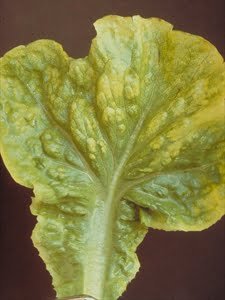
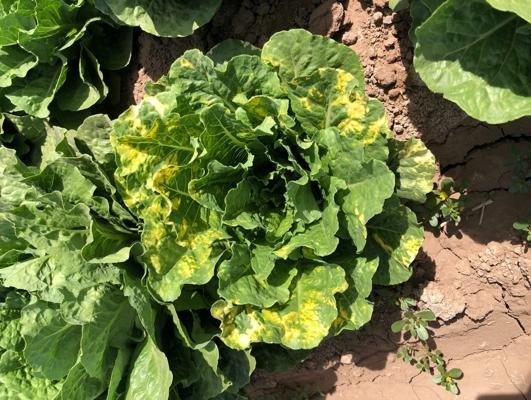
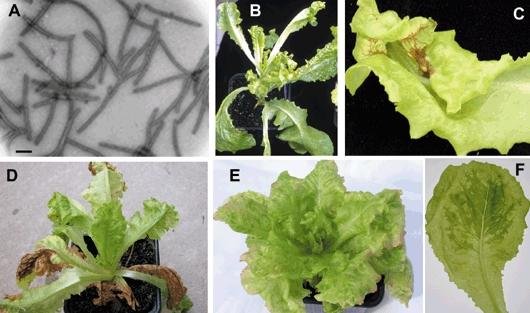
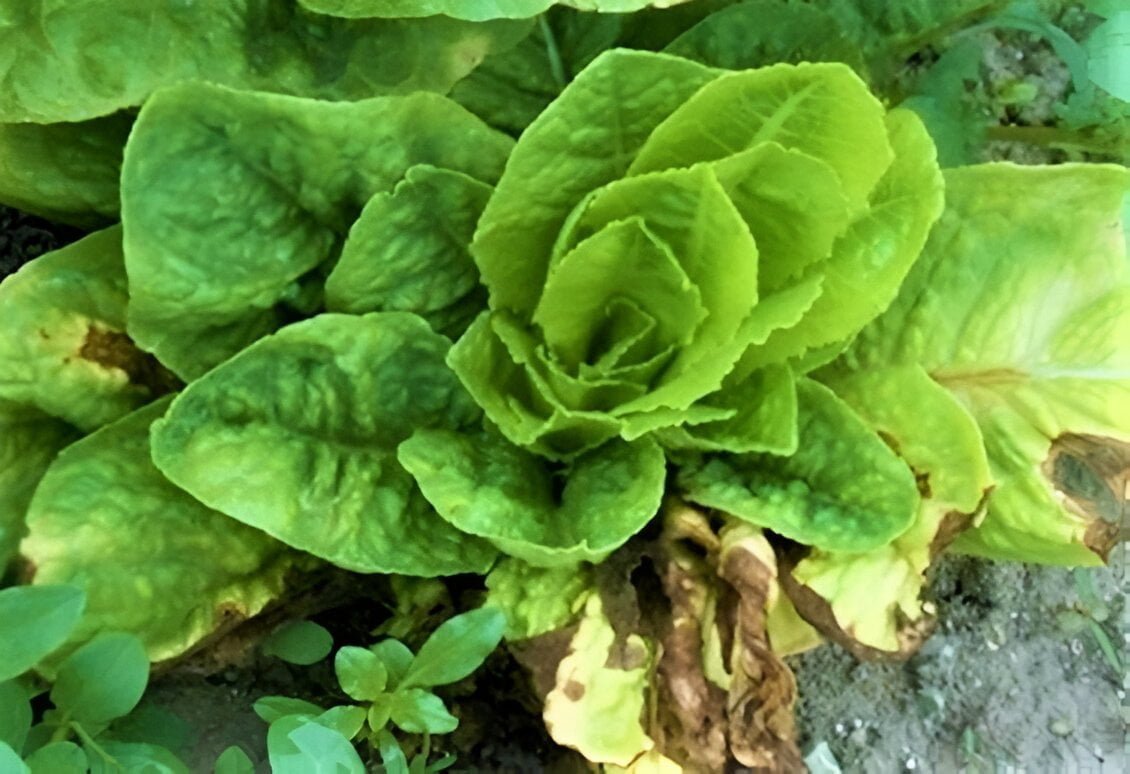

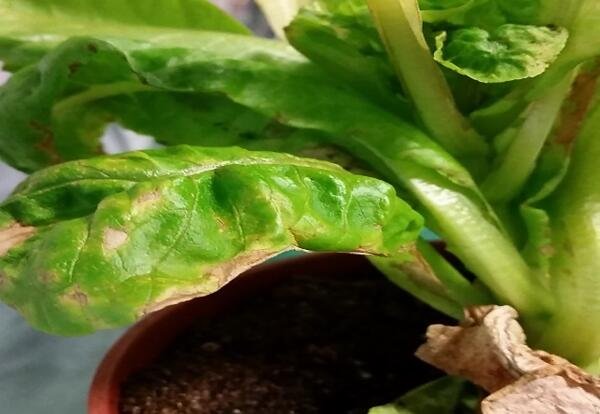
Preventive measures for lettuce mosaic disease
- Producing virus-free seeds and using them in agriculture.
- Eliminate infected plants in the field early whenever possible.
- The seed beds from which lettuce seedlings are taken should not be close to old lettuce crops or other crops susceptible to the disease. When performing the transplanting process, we dip the seedlings in the nicotine solution.
- Resisting aphids using insecticides, even though treating young plants may not prevent infection with the virus. In general, aphids on infected old plants must be controlled before the aphids produce large numbers of winged individuals.
Organic control of lettuce mosaic disease
Try to control lettuce mosaic in two ways. The first method is to test for the virus in seeds and then sow uninfected seeds. Testing is done in three different ways: direct reading of lettuce seeds, inoculation of seeds with the index host or through a serological technique. The goal is to only sell and plant uninfected seeds for every 30,000 seeds tested. The second way to control lettuce mosaic is to incorporate virus resistance into the seeds themselves.
Consistent weed control and prompt tillage of harvested lettuce are important in controlling LMV, as is curative management. There are currently some LMV resistant varieties of lettuce.
Chemical control of lettuce mosaic disease
Insecticides are not recommended to control aphids that spread the virus. The time is very short between an aphid absorbing the virus when it feeds on a diseased plant and spreading the virus when it feeds again on a healthy plant. By the time the insecticide killed the aphid, it had spread the virus.
In conclusion, we would like to note that we, at the world of plants website, offer you all the necessary services in the world of plants, we provide all farmers and those interested in plants with three main services::-
- Artificial intelligence consulting service to help you identify diseases that affect plants and how to deal with them.
- Blog about plants, plant diseases and care of various crops ... You are currently browsing one of her articles right now.
- An application that provides agricultural consultations to clients, as well as a service for imaging diseases and knowing their treatment for free – Click to download the Android version from Google Play Store، Click to download the IOS version from the Apple App Store.
References:
- Authors Graham Jackson
- Information from CABI (2019) Lettuce mosaic virus (Lettuce mosaic). Crop protection summary. (https://www.cabi.org/cpc/datasheet/30269); (Image 1) Vegetable crop diseases in Australia (2010). Editors, Dennis Persley, et al. CSIRO publication; and lettuce mosaic virus. Wikipedia. ( https://en.wikipedia.org/wiki/Lettuce_mosaic_virus ); Lettuce mosaic virus (Lettuce mosaic virus, LMV). Grooveig. (https://www.growveg.com.au/plant-diseases/uk-and-europe/lettuce-mosaic-virus/). Image 2 Koehler F, et al. (1997) Diseases of crops grown in Pacific Island countries. South Pacific Commission. Perry Printers Pty Ltd, Canberra, Australia.
- Produced with support from the Australian Center for International Agricultural Research under project PC/2010/090: Promoting integrated crop management research in the Pacific Islands to support the sustainable intensification of high-value crop production, implemented by the University of Queensland and the Pacific Community Secretariat.
- F., editor. (2017). Summary of diseases and pests of lettuce. APS, American Plant Pathology Society. ISBN 978-0-89054-577-5. OCLC 1001462719. {{cite book}}: |last=It has a common name (help)
- Mullen, Harold E. (1987). Market diseases affecting beets, chicory, chicory, escarole, artichoke, lettuce, rhubarb, spinach and sweet potatoes. Washington, DC: US Department of Agriculture, Agricultural Research Service.
- Dinant, S.; Lott, H. (2007-04-05). “Lettuce mosaic virus.” Plant diseases. 41 (5): 528-542. doi: 10.1111/j.1365-3059.1992.tb02451.x.
- Persley, Dennis. Cook, Tony; House, Susan, eds. (2010). Diseases of vegetable crops in Australia. doi: 10.1071/9780643100435. ISBN 9780643100435.
- Zink, FW (1956). The effect of seed transmission rate on the subsequent spread of lettuce mosaic virus. Plant pathology. pp. 662-664.
- Ryder, E. J. (1973). “Transmission of lettuce mosaic virus in seeds of mosaic-resistant lettuce.” Journal of the American Society of Horticultural Sciences. 98 (6): 610-614. doi: 10.21273/JASHS.98.6.610. S2CID 83445381.
- Smith, Kenneth (1973). A textbook on plant virus diseases. Manly.
- Walkey, DGA; Payne, C. J. (March 1990). “The interaction of two varieties of lettuce with mixed infection with western beet yellows virus, lettuce mosaic virus, and cucumber mosaic virus.” Plant diseases. 39 (1): 156-160. doi: 10.1111/j.1365-3059.1990.tb02486.x. ISSN 0032-0862.
- Kraus-Sacati, Renate; Le Gall, Olivier; Fakhfakh, Hatem; Pipilot, Martine; Marrakshi, Muhammad; Farferi, Christina; Pavan, Marcelo A; Sushi, selfie; Lot, Hervé (2002). “Molecular and biological characterization of lettuce mosaic virus (LMV) isolates reveals a distinct and widespread type of resistance-breaking isolate: LMV-Most.” Plant pathology. 92 (5): 563-572. doi: 10.1094/PHYTO.2002.92.5.563. ISSN 0031-949X. PMID 18943032.




